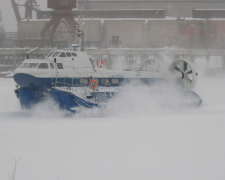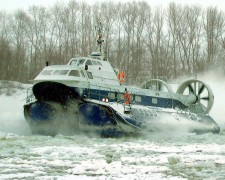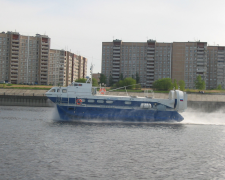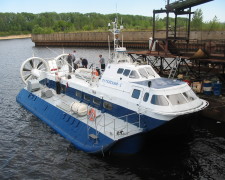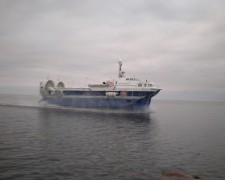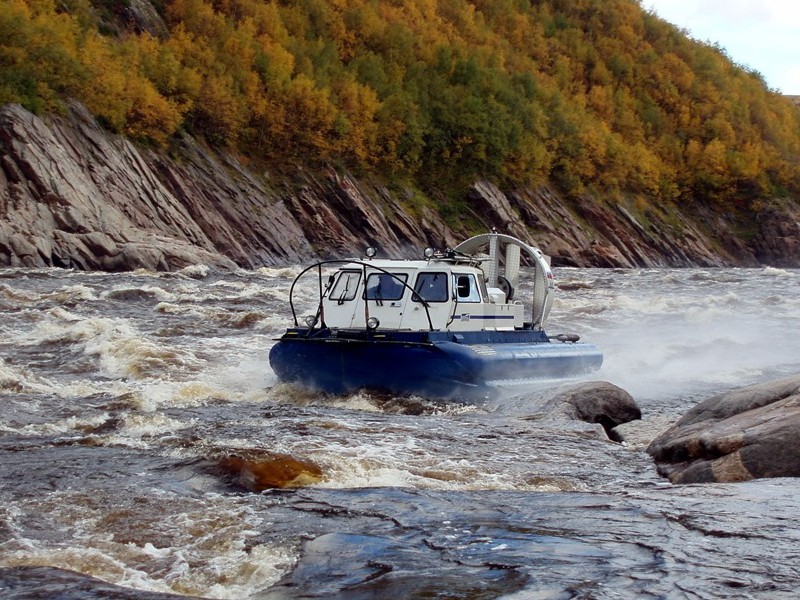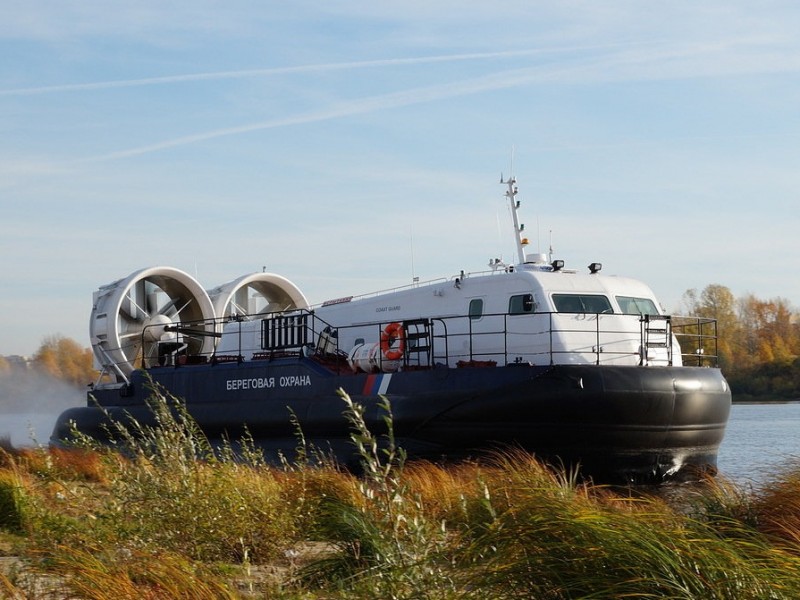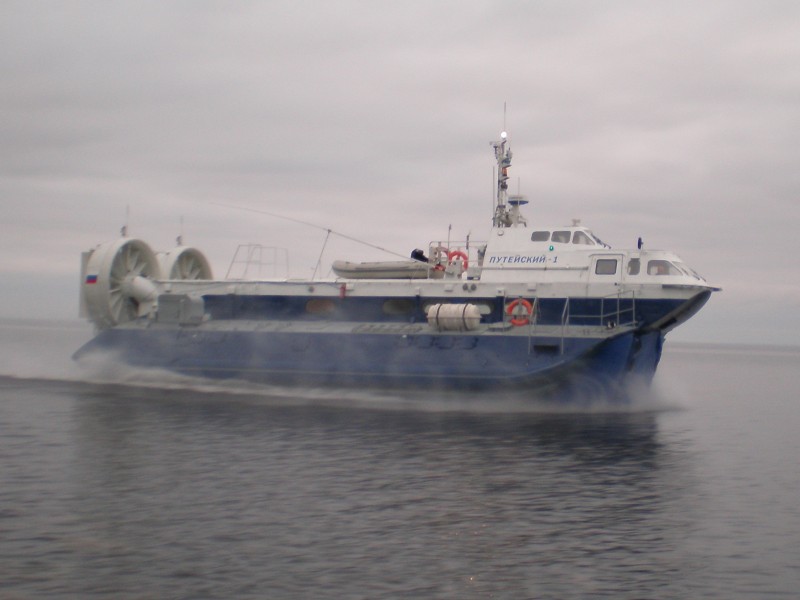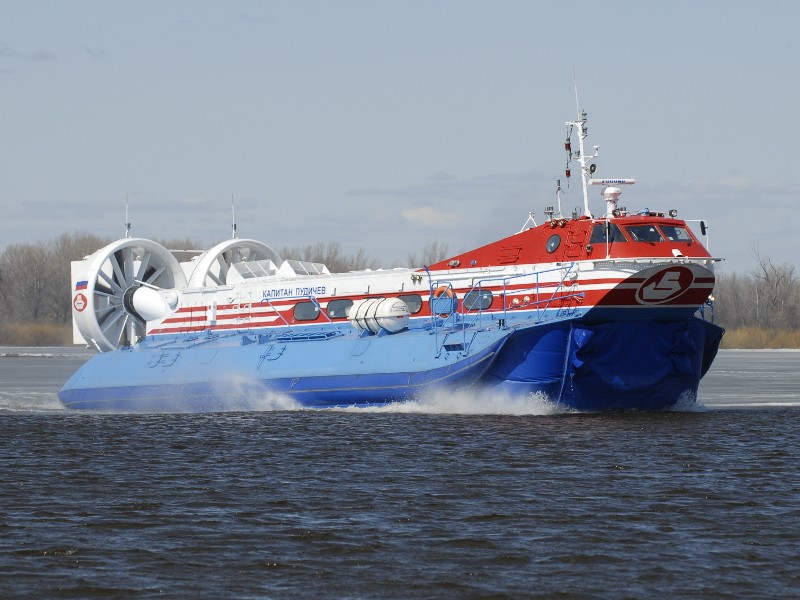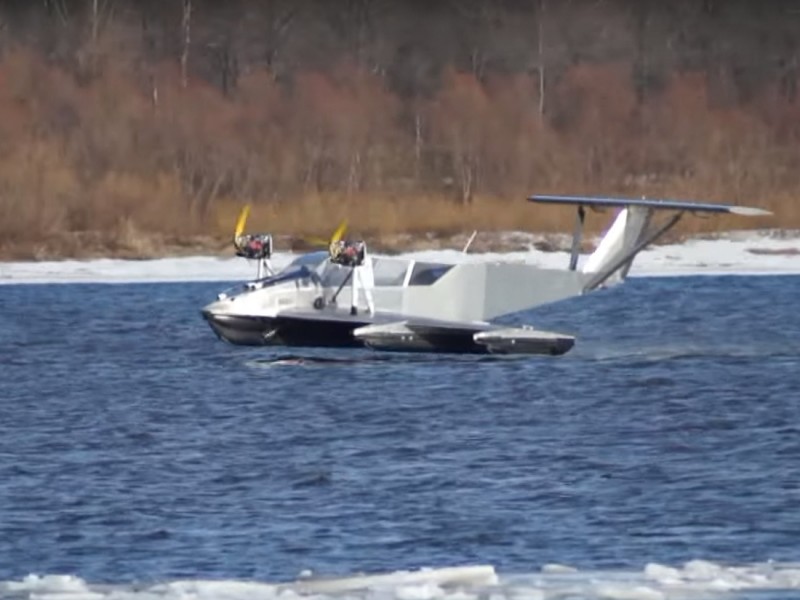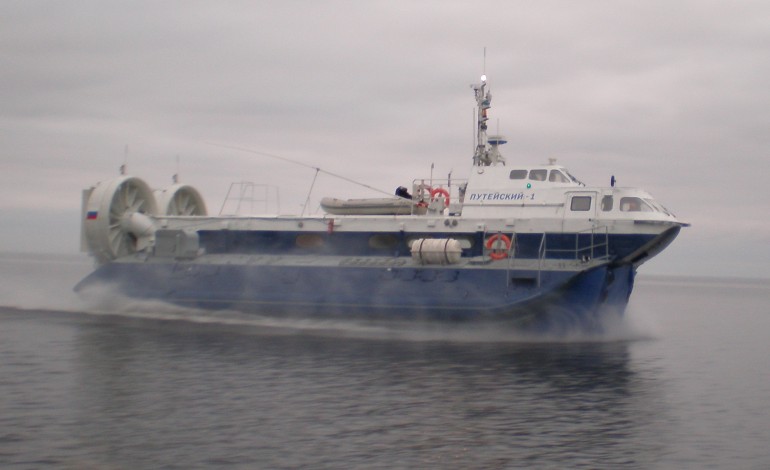
Purpose: year-round passenger and cargo transportation in inland and coastal waters.
Area and operation conditions:
- water basins with max wave height 2.5 m (occurence 3%) and max wind speed 15 m/s;
- non-navigable waters: shallow, frozen and snow-covered waters, broken ice with obstacle height up to 0.8 m and surfaces with max incline 6о;
- operation temperature range from – 35oC to + 40oC.
Type of vehicle: amphibious passenger/cargo hovercraft.
Russian River Register Classification: M-SP 2,5/1,2 SVP.
Main characteristics (passenger version)
| Payload, kg | 3500 |
| Passenger capacity, prs. | 12 |
| Length on air cushion, m | 18,5 |
| Beam on air cushion, m | 8,0 |
| Height on air cushion (without mast), m | 4,5 |
| Transportation dimensions, m | 17,7 х 3,2 х 3,73 |
| Engines | Mercedes OM501LA |
| Number of cylinders and their arrangement | 6, V-type |
| Volume capacity, l | 11,95 |
| Nominal power, kW (hp) | 2 x 315 (2 x 428) |
| Crew, prs. | 2 |
| Cruising speed on water, km/h | 60 |
| Cruising speed on snow, km/h | 70 |
| Climbing angle, degrees | 6 |
| Obstacle clearance, m | 0,8 |
| Fuel consumption, l/h | 130 |
| Proppelling system | two 6-blade propellers in ring |
| Air cushion | inflatable balloons, front and rear skirts |
| Min operation temperature, degrees C | -35 |
| Max wind speed, m/sec | 15 |
Detailed decsription
Hull and superstructure. Material of hull and superstructure – aluminium-magnesium alloy. The connection elements of the hull and superstructure are rivets. Riveting of impermeable seams is made with sealants. Hull consists of three sections: central section, made together with superstructure and two removable side sections that are designed to reduce transportation width down to 3.2 m. The removable side sections are connected by means of bolts through the upper and lower planes of the sections.
Air-cushion. A flexible enclosure air-cushion consists of three inflatable balloons, bow, stern and Central skirts. To protect against wear and damages of the bottom surface of the flexible enclosures have a polyurethane coating. The pressure regulation system in the lower balloons allows you to change the pressure on Parking and while driving. Vessel movement is controlled by air rudders mounted behind the main propellers. Air rudders are driven by the hydraulic system.
Engine systems. Fuel, lubricating, cooling, air charging, charged air cooling, exhaust systems, etc. are identical to car systems.
The engines drive air cushion charging and propulsion systems via the clutch, toothed belts and drive shafts.
Air cushion charging system consists of 4 centrifugal fans. Each of the fans charges air into the corresponding section of the air cushion.
Propulsion system consists of two counter-rotating adjustable pitch propellers in rings. Hydraulic control system enables to change the angle of the blades and provides a reverse thrust by means of the main propellers.
The air cushion consists of three inflatable balloons (2 side balloons and 1 central one), bow and stern skirts. To protect from wear and damage the lower surfaces of balloons and skirts have a polyurethane coating. The pressure regulation system allows you to change the pressure in the lower balloons, both at rest and during movement.
The ship is steered via air rudders installed behind the main propellers. Air rudders are driven by means of the hydraulic system.
Interior layout and equipment. The passenger compartment can accommodate 12 passengers. If necessary, the seat pitch can easily be modified or all seats can be dismantled, and the vacant volume can be used for cargo transportation purposes.
Shelves for personal belongings of passengers can be placed above the seats on the right and left sides of the saloon.
The saloon can also have a galley, equipped with a stove, refrigerator, coffee maker, microwave oven, sink with hot and cold water, lockers for dishes.
The toilet is equipped with a toilet bowl and washbasin.
If necessary, the craft can have a cabin for crew accommodation with two beds, a desk with drawers for utensils, a hanger for outer clothing. In the cabin there can be installed a refrigerator with a volume of 40-60 liters.
Marine systems. Drinking water is stored in a 150 l tank. Water to the wash basin and the toilet is fed by the force of gravity. Drinking water is heated by a built-in electric heater.
The ventilation system provides forced ventilation of all ship compartments.
Upon customer’s request the passenger compartment can be equipped with an air conditioning system.
Pre-heating of the engine at low ambient air temperatures is provided by two self-contained liquid-fuel Webasto heaters. They also provide heat to living compartments of the vessel when the main engines are idle. When the main engines are running they provide heating of living compartments via the engine cooling system.
Anchor device consists of two Matrosov anchors, 16 kg each with 16 mm nylon anchor rope 75 meters long. The anchor is dropped and raised manually.
Electric equipment. The on-board electric network is based on 24 V direct current.
The main sources of electricity on the ship are eight batteries, pairs connected in series and two 28V DC generators, 2,0-3,4 kW each, installed on the main engines.
The power supply of the 24 V on-board network can be provided from the coastal source 220V, 50Hz via on-board 600W charger/rectifier.
Also, at the Customer’s request it is possible to install a self-contained diesel generator connected to the network 220 V, 50 Hz.
Exterior lighting is provided by spotlights and fog lights. To perform mooring and maneuvering in narrow waters a swivel search light controlled from the wheelhouse can be installed.
Cabin windshields are equipped with wipers.
To prevent freezing of the windshields when driving on the open water at sub-zero ambient temperatures, the windshield can be made double-glazed and equipped with a washer with a de-icing liquid.
Emergency and signal equipment. Fire extinguishing system in the engine compartment with remote control from the wheelhouse;
- five portable fire extinguishers and a set of fire tools;
- two life rafts;
- life jackets;
- life buoys with line;
- a set of navigation lights and day signals;
- pyrotechnic signal devices.
Radio communication equipment. The vessel has the following radio communication equipment:
- VHF radio station (sea type) IC-M402 – 1 set;
- VHF radio station (rescue type) IC-GM1500 – 2 sets;
- HF radio station FS-1570 – 1 set;
- portable VHF radio station (300.025 – 300.225 MHz) – TW-80 – 3 units;
- speakerphone and broadcast system EURO700 – 1 set;
- emergency satellite EPIRB COSPAS-SARSAT SEP-406 – 1 unit;
- ship earth station “Inmarsat C” – Felcom-15 – 1 unit;
- radar beacon “Sigma-S” – 1 unit;
- satellite terminal of “Globalstar” sysytem – GSP-2800M.
Navigation equipment:
- track magnetic compass type DS-83 PS-2A – 1 unit;
- navigation complex NAVNET including the following:
a) satellite navigation system (GPS) GP-320B – 1 set;
b) radar station M-1833C – 1 set;
c) echo sounder ETR-6/10N – 1 set;
- ship’s clock – 1 unit;
- aneriod barometer – 1 unit;
- stop watch – 1 unit;
- anemometer – 1 unit;
- glasses – 1 pc.;
- free air thermometer – 1 unit.
Depending on sailing conditions, the composition and brands of radio communication and navigation equipment are determined together with the Customer.



